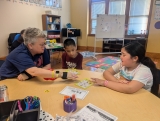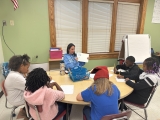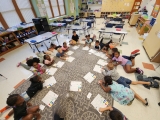-
Category 2
Selected in 2024
-
Grades: k - 5
School Setting: suburban
Town Population: 16,936
Student Enrollment: 535
Student Demographics:
Black/African American: 33%
Teacher/Student Ratio: 1:17
White/Caucasian: 33%
Hispanic: 16%
Hawaiian/Pacific Islander: 0%
Asian: 3%
Native American: 0%
Other: 15%
% Reduced Lunch: 80.3%
% ELL Learners: 7%
Founded: 1925 -
PRINCIPAL:
Erik Johnson -
CONTACT:
250 N. Third Street
Albemarle, NC 28001
704-961-3200
erik.johnson@stanlycountyschools.org
Central Elementary School
Albemarle, NC
"We believe we improve the rates of learning for our students by meeting their needs with immediacy."
- 1. Tell us about your school’s success.
- At Central Elementary, we believe that every child is capable of success when their needs are met and when appropriate and timely support is provided. While it sounds simple, it has been a process three years in the making - with more work to do! Over the past three years, we have persistently focused on building from the bottom up - starting with identifying strong core resources, establishing student centered instructional routines and implementing best practices that focus on high levels of engagement. Without losing time for our students, we simultaneously worked with staff to understand and respond appropriately to their students’ data through the implementation of layered interventions and enrichment opportunities focused on what every child needs first. As a result, we have seen gradual increases in student proficiency across multiple subgroups, most notably our accomplishment of closing the achievement gap between White and Multiracial students by 27.6 points in just two years!
- 2. Talk about the greatest contributing factor(s) that promoted positive change in your school.
- For a school with traditionally low proficiency rates, the greatest contributing factor to our school's success is our focus on growing students and less emphasis on proficiency - focusing on individual trees opposed to the entire forest. We believe that if we can improve the rates of learning for our students by meeting their needs with immediacy, we can help them achieve proficiency. We work to make this possible by focusing on building teacher efficacy - helping teachers lead in their own classrooms. This approach includes the effort by all to establish a positive school culture, high expectations for student learning, data-driven decision-making to inform instruction and an emphasis on effective and engaging teaching practices. All of these components are embedded in our daily routines through intentional professional learning, collaboration, coaching/feedback and distributive leadership.
- 3. How has ESEA funding supported the school's success?
- ESEA funding is instrumental in what we are able to provide for our students. Our students thrive in small group learning opportunities where their needs can be prioritized and they are highly engaged. As such, we believe that the best investment of ESEA funding is in people/staff. Through ESEA funding, we have been able to add a number of positions that make it possible for us to provide meaningful small group opportunities. We have added a second Instructional Coach to balance the levels of classroom support needed by our beginning teachers relative to our veteran teachers. Additionally, we have also added and sustained the addition of two Title 1 Instructional Assistants and 3 Title 1 Tutors - with the designed purpose of providing tiered interventions for underperforming students across all grade levels. With whatever funding remains, we focus on purchasing supplemental resources that support intervention needs as well as our core curriculum.
- 4. What professional development activities were used to improve teaching and learning?
- We aim to be intentional in how we solicit input and differentiate the professional learning needs of our staff. With half of our staff beginning teachers (those in their first 3 years), their needs are often quite different from those of our veteran staff. Providing differentiated support based on individual or grade level need has enhanced fidelity with our implementations. One school wide difference is our implementation of the Get Better Faster framework. We use this framework to support all of our new teachers as well as those struggling to provide strong instruction. This framework guides our teachers to be intentional with feedback and responsive to how students respond to instruction. Another vital PD that has a positive impact is our CHAMPS behavior expectations from Safe and Civil Schools. This implementation has helped curb disruptive/off-task behaviors as students more readily know what is expected of them at all times (including transitions within the classroom).
- 5. Talk about the cultural shift leading up to your school's success.
- At Central, we have established a culture of collective responsibility for student success by setting the expectation that EVERY child is the responsibility of EVERY adult. This is most observable within each grade level, where every child belongs to the collective team of teachers. This is a transformation from the isolation teachers previously worked in, which resulted in limited consistency in what students were exposed to or able to do. Today, with continuous improvement as the catalyst, our collaborative teams work together to unpack standards, analyze student work and determine measures of progress that meet the rigor of the standards. As a school, data analysis always starts at the grade level before drilling down to the classroom. Identifying trends across a grade level has helped us determine what instructional strategies were most effective for student learning as well as how we can align students needing support to those most effective at teaching specific skills.
- 6. How has community involvement strengthened your success?
- Community involvement is vital for our students’ success as it promotes collaboration among staff, students and their families and local organizations. The engagement we experience through the consistent partnerships we’ve forged within the community have helped to facilitate PBIS program enhancements/rewards, increase exposure for our students through field trip sponsors, celebrate staff during Teacher Appreciation Week and monthly breakfasts and solicit volunteers dedicated to the beautification of the school grounds. These collaborative relationships are instrumental in our being able to focus on what matters most - teaching and learning - eliminating the worry of financial or time-related hurdles that often slow progress down. Our community partnerships have enriched the educational experience for our students by helping to increase student attendance, improve academic performance and enhance the sense of belonging for students and their families.
Stats
-
Category 2
Selected in 2024
-
Grades: k - 5
School Setting: suburban
Town Population: 16,936
Student Enrollment: 535
Student Demographics:
Black/African American: 33%
Teacher/Student Ratio: 1:17
White/Caucasian: 33%
Hispanic: 16%
Hawaiian/Pacific Islander: 0%
Asian: 3%
Native American: 0%
Other: 15%
% Reduced Lunch: 80.3%
% ELL Learners: 7%
Founded: 1925 -
PRINCIPAL:
Erik Johnson -
CONTACT:
250 N. Third Street
Albemarle, NC 28001
704-961-3200
erik.johnson@stanlycountyschools.org










